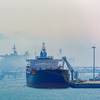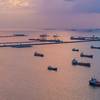Total annual operating costs in the shipping industry fell by an average of 1.1 percent in 2016, says international accountant and shipping consultant Moore Stephens. This compares with the 2.4 percent average fall in costs recorded for 2015. For the second successive year, all categories of expenditure were down on those for the previous 12-month period, most notably for insurance costs and stores.
The findings are set out inMoore Stephens’ ship operating costs benchmarking tool OpCost 2017, which reveals that total operating costs for the tanker, bulker and containership sectors were all down in 2016, the financial year covered by the study. On a year-on-year basis, the tanker index was down by 3 points, or 1.7 percent, while the bulker index also fell by 3 points, or 1.9 percent. The containership index, meanwhile, was down by 1 point, or 0.6 percent. The corresponding figures in last year’s OpCost study showed falls of 6 points in both the bulker and containership index, and of 4 points in the tanker index.
There was a 0.4 percent overall average fall in 2016 crew costs, compared to the 2015 figure, which itself was 1.2 percent down on 2015. By way of comparison, the 2008 report revealed a 21 percent increase in this category. Tankers overall experienced a fall in crew costs of 1.8 percent on average, compared to the 1.3 percent fall recorded in 2015. All categories of tankers reported a reduction in crew costs for 2016 with the exception of Aframax Tankers and Suezmax Tankers, which recorded increases of 0.8 percent and 0.2 percent respectively, compared to reductions for 2015 of 1.9 percent and 2.6 percent. The most significant reductions in tanker crew costs for 2016 were the 2.8 percent and 2.7 percent recorded by Tankers 5,000 to 10,000 dwt and by Handysize Product Tankers respectively.
For bulkers, meanwhile, the overall average fall in crew costs in 2016 was 0.6 percent, compared to 1.1 percent recorded 12 months ago. All categories of bulkers reported a reduction in crew costs, the biggest fall being the 1.2 percent reduction in spending by the owners of Capesize Bulkers.
Expenditure on crew costs in the containership sector, meanwhile, was up by 1.1 percent compared to the fall of 3.3 percent recorded for 2015. The biggest increase in this category was the 2.1 percent recorded for ships of between 2,000 and 6,000 teu, which in 2015 led the reductions in the containership crew costs category with a fall in expenditure of 3.6 percent.
Expenditure on stores was down by 2.9 percent overall, compared to the fall of 4.3 percent in 2015. The biggest fall in such costs was the 5.1 percent recorded by owners of containerships of between 100 and 1,000 teu. In the same tonnage category, the fall in stores costs for owners of containerships of between 1,000 and 2,000 teu was 4.9 percent, the same figure as that recorded in the tanker sector for Aframax Tankers. Other significant reductions included Handysize Bulkers (4.8 percent) and Panamax Bulkers (4.4 percent).
For bulk carriers overall, stores costs fell by an average of 4.2 percent, compared to a fall of 7.7 percent in 2015, while in the tanker and containership sectors the overall reductions in stores costs were 2.2 percent and 5.2 percent respectively, compared to the corresponding figures of 4.3 percent and 5.5 percent for 2015. The only rise in stores expenditure by any category of vessel was the 0.3 percent increase recorded by Coastal Tankers.
There was an overall fall in repairs and maintenance costs of 0.8 percent in 2016, compared to the 4.3 percent reduction recorded for 2015. The biggest fall in such costs was that recorded by Panamax Bulkers (3.2 percent), closely followed by Capesize Bulkers (3.1 percent). All vessels in the bulker category recorded reduced repairs and maintenance expenditure, but there were increases in the tanker sector, most notably the 2.4 percent additional outlay by Panamax Tankers compared to 2015. There were examples of small increases in repairs and maintenance expenditure in the containership sector, while for Ro-Ros the increase amounted to 2.2 percent.
The overall drop in costs of 3 percent recorded for insurance compares to the 3.2 percent fall recorded for 2015. No vessel types in any of the tonnage and size categories included in OpCost paid more for their insurance in 2016 than in 2015.The biggest reduction in such costs was the 5.2 percent recorded by containerships of between 2,000 and 6,000 teu. Not far behind were Handysize Bulkers and Panamax Bulkers (4.7 percent and 4.6 percent respectively), while in the tanker category it was Aframax Tankers which led the way in terms of reduced insurance expenditure (4.6 percent). Ro-Ro owners, meanwhile, paid 4 percent less for their insurance in 2016 than in 2015, in which year they spent an additional 2.4 percent in premiums compared to the previous year.
Richard Greiner, Moore Stephens Partner, Shipping & Transports, says, “This is the fifth successive year-on-year reduction in overall ship operating costs, although the reduction this time is less than half the figure recorded 12 months ago for 2015.
“The biggest cost reductions were those in the Insurance category. Insurance is a major item of expenditure for all owners and operators, without which most would not be able to operate on an international basis. The fact that such costs continue to fall may be due in part to a reduction in the incidence of major casualties. Most of the larger reductions in insurance costs tracked by OpCost, however, were recorded by bulk carriers, which are no strangers to the pages of the casualty reports. So cheaper insurance must also say much about the fierce competition for business which exists throughout marine underwriting markets worldwide.
“The next biggest cost reduction was in the Stores category, where the slower than anticipated improvement in world oil prices doubtless had a continuing beneficial knock-on effect on lube oil costs in 2016.
“The reduction in Repairs and Maintenance costs in 2016 was 3.5 percent down on the figure for the previous year. This confirms that maintenance can only be postponed for so long by owners and operators who accept the need to invest in their ability to compete for business in a highly competitive market which is more tightly regulated than ever before. Strategic short-term lay-up is a waypoint rather than a destination.
“Over the years, the OpCost study has recorded annual average crew cost increases of more than 20 percent, but there was a reduction in such costs this time of less than half of one percent compared to the figure for 2015. The continuing challenging shipping markets are doubtless a significant factor.
“Although 2016 was another difficult period for shipping, the year closed on a note of rising confidence, according to the Moore Stephens Shipping Confidence Survey. Owners and charterers were more confident, than for some time previously, of making new investments, and there were improved expectations of higher freight rates in all three main tonnage categories. The expectation, too, was that oil prices and the Baltic Dry Index could only go up.
“That increased confidence, which has carried over into 2017, should logically lead to greater activity, which will mean higher operating costs. When freight rates allow owners to absorb such increased costs, the numbers start to look healthy. At present, however, owners and operators are not earning what they should be, or would like to be, from most of the markets in which they operate. Positive net sentiment is good, but it is not enough. Something has to change.
“It is also true that in shipping – as elsewhere – what goes down must come up. For example, OpCost records that, at year-end 2008, the average daily operating cost for a Capesize Bulker was $7,512. In 2016, it was $6,691. For a VLCC, the comparable figures are $10,812 and $9,950 respectively.
“Future OpCost studies are likely to reflect the start of spending – or planning for – the introduction of the likes of the Ballast Water Management Convention, the new global limit on SOx emissions from 2020 and initiatives to contain cyber-crime, which are assuming increasing importance in the industry. The results will also reflect, albeit subtly, the effect of geopolitical developments, which can seldom have been in a greater state of flux than they are today.
“Shipping can certainly find encouragement in a fifth successive annual fall in operating costs. But nothing is forever, and nothing is more certain than that the shipping industry will continue to be characterized by uncertainty, which can be both its strength and its weakness.”















